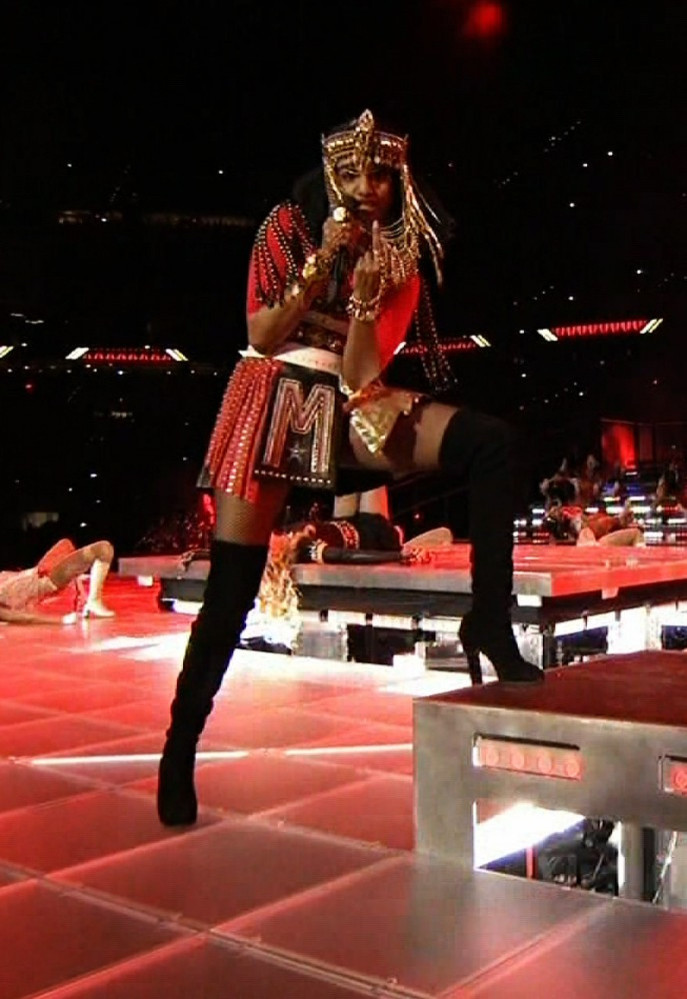MIA Middle Finger: The Psychology behind Flipping the Bird

M.I.A. not only bounced on stage with Madonna and Nicki Minaj during Sunday's Super Bowl halftime show, she shocked the audience by giving them the middle finger.
The crude gesture came from the Sri Lankan rapper during her solo spot in the halftime show where M.I.A. and American rapper Minaj acted as Madonna's cheerleaders.
Before Sunday's incident that upstaged Madonna's much-hyped halftime show, M.I.A. was known for her 2007 hit Paper Planes.
Viewers speculated whether M.I.A.'s gesture - accompanied by her telling viewers I don't give a (explicative) - was a provocation to gain attention for her forthcoming album or rebellion against looking like she had sold out to mainstream audiences.
NBC, the network that aired the Super Bowl, and the NFL apologized after the incident.
The NFL hired the talent and produced the halftime show, NBC spokesman Christopher McCloskey said in a statement to The Hollywood Reporter. Our system was late to obscure the inappropriate gesture and we apologize to our viewers.
The obscene gesture in the performance was completely inappropriate, very disappointing and we apologize to our fans, Brian McCarthy, spokesman for the NFL, which produced Madonna's halftime show, told The Associated Press.
The middle finger is a way of telling someone off without saying a word. Psychologists found that flipping the bird can bring hostile feelings not only for the person being flipped, but unintentionally lifting the middle finger can bring hostility to flippers themselves.
Psychology professors Jesse Chandler and Norbert Schwarz at the University of Michigan looked at the connection between emotions and the middle finger in a study published in 2008.
Chandler and Schwarz recruited 58 students and had the volunteers read a story that included a fictional character Donald, who was portrayed as a difficult tenant. The psychologists showed the students which finger to extend while reading the story and after surveyed the volunteers on their feelings about the fictional character Donald.
The psychologists were careful not to use the loaded term middle finger and instead relied on the students following a more neutral pictorial free of language.
In general, the volunteers who stuck out their middle finger harbored more hostility in general and towards the Donald character.
Making the middle-finger gesture brings hostile thoughts to mind, Chandler told Time in 2009. In our studies, participants were not even aware that their finger movements resembled 'the finger,' and they nevertheless perceived an unrelated other as a more hostile person.
The study appeared in the Journal of Experimental Social Psychology.
The middle finger isn't the only digit that communicates wordlessly - a thumbs up indicates 'good job' or 'well done'. Chandler and Schwarz delved into this upbeat gesture and found that in a similar experiment with 74 other student volunteers, thumbs up gave more positive feelings. Women reported becoming more positively affected by the gesture than men, a difference that the researchers did not observe with the middle finger.
Though M.I.A. flipped the bird for a worldwide audience, psychologist Chandler said that even giving the gesture in secret can have an impact.
Even when nobody sees the gesture, it may have an adverse effect, Chandler said, leaving us more convinced that other people are nasty and hostile. This may lead to additional hostile acts down the road.
The M.I.A. incident harked back to the 2004 Super Bowl halftime show when Justin Timberlake ripped off Janet Jackson's bustier and exposed her right breast.
The Federal Communications Commission that regulates U.S. airwaves fined CBS $550,000, a fine later thrown out by the U.S. Supreme Court.
© Copyright IBTimes 2024. All rights reserved.




















